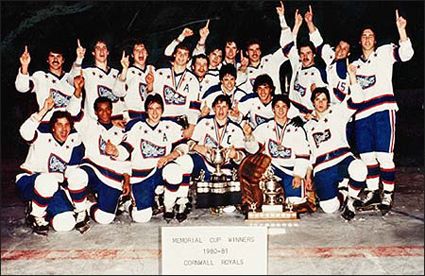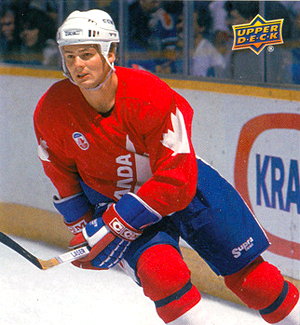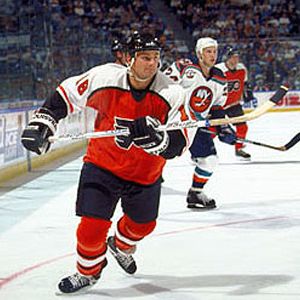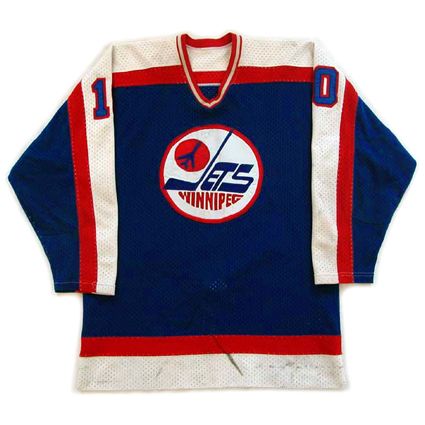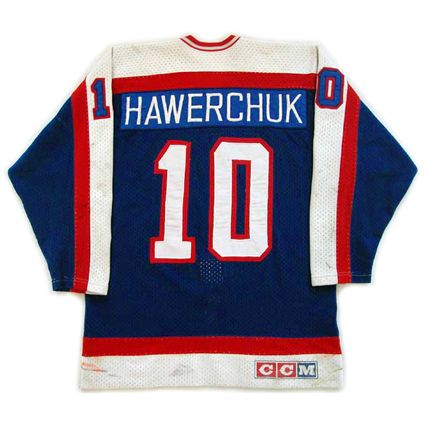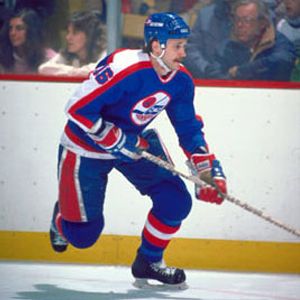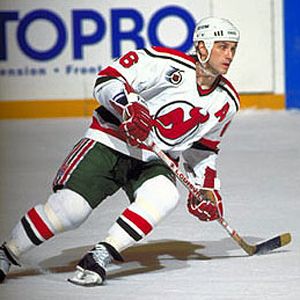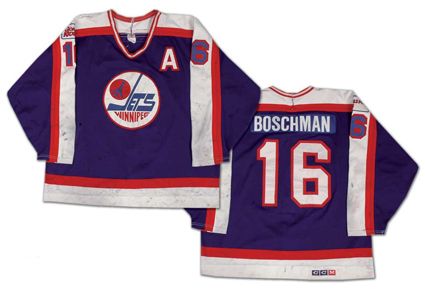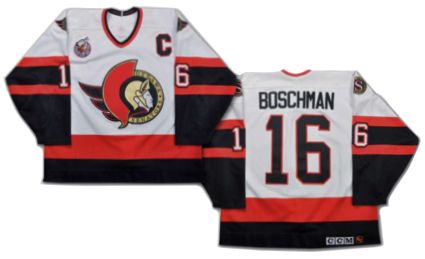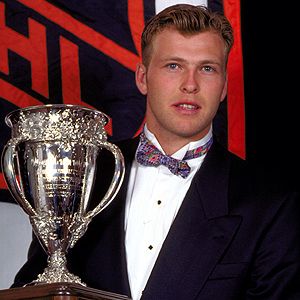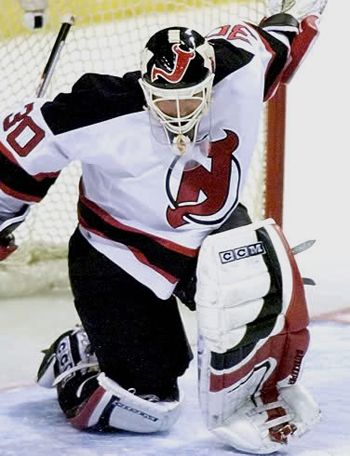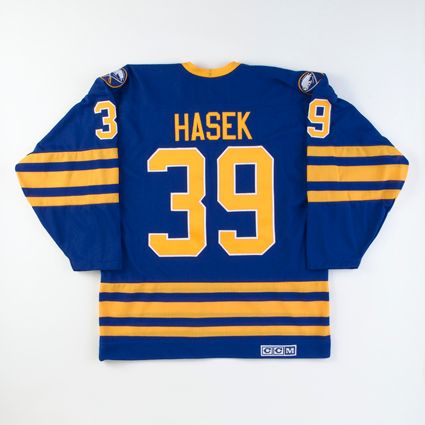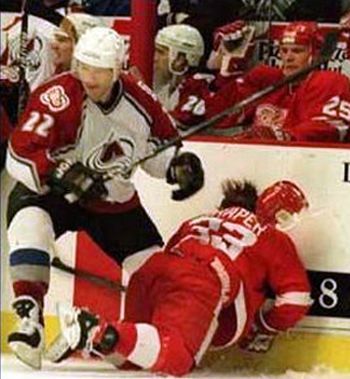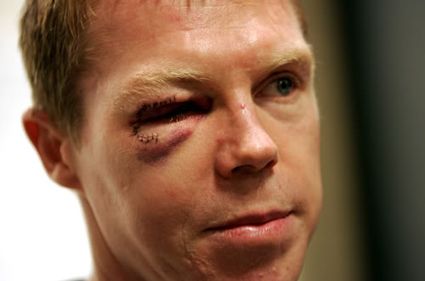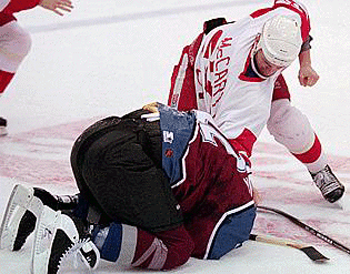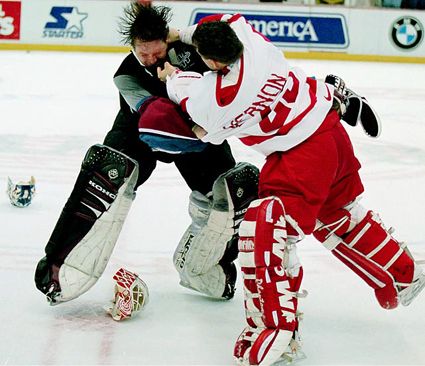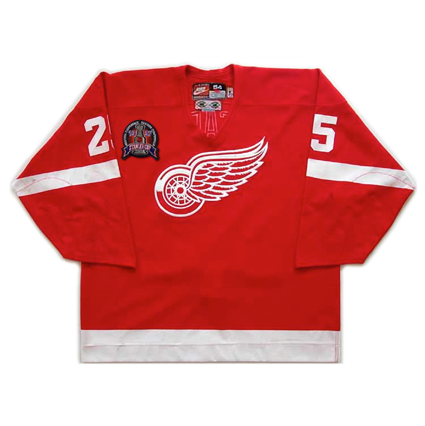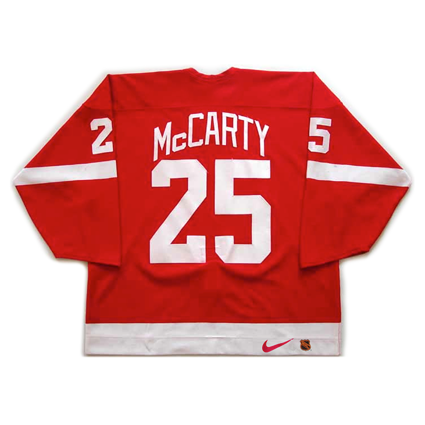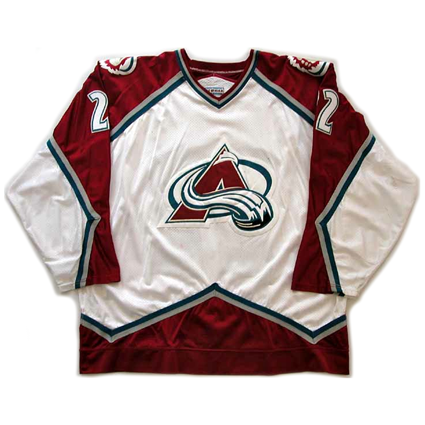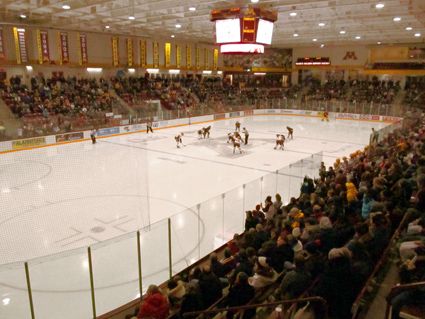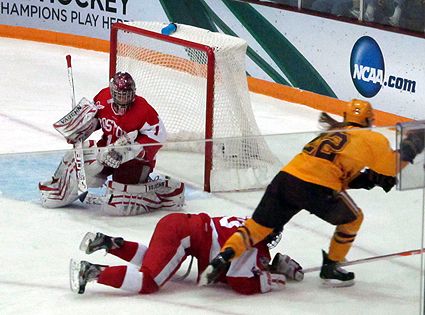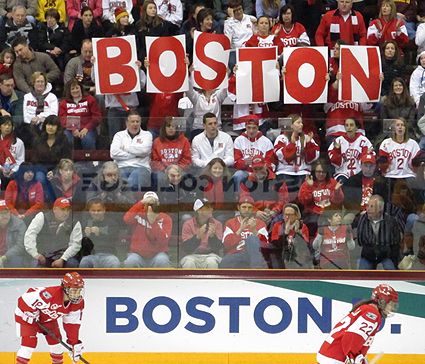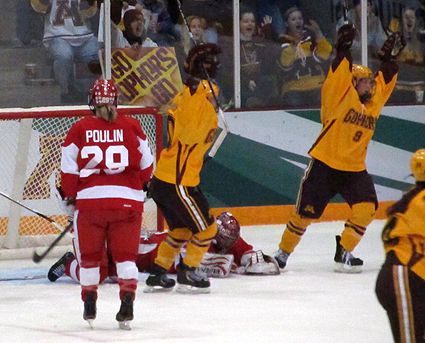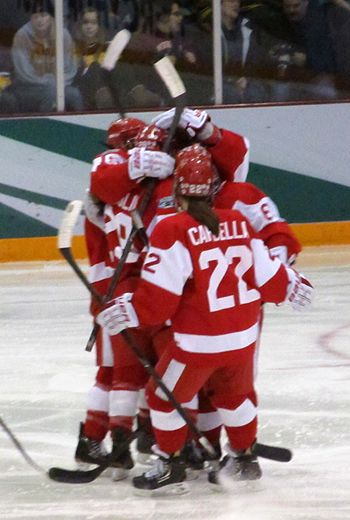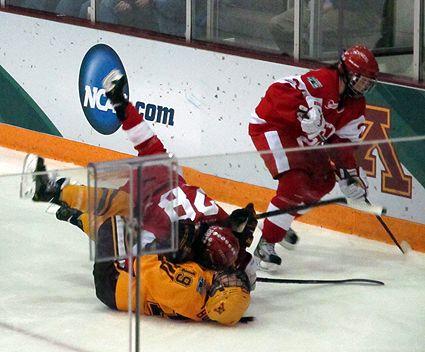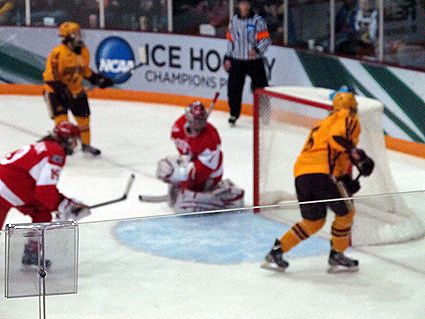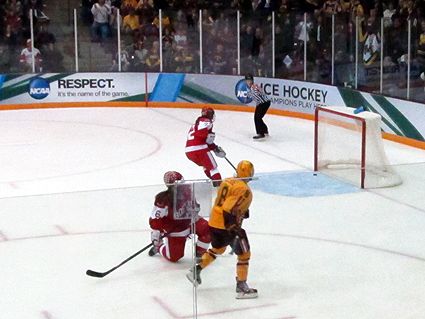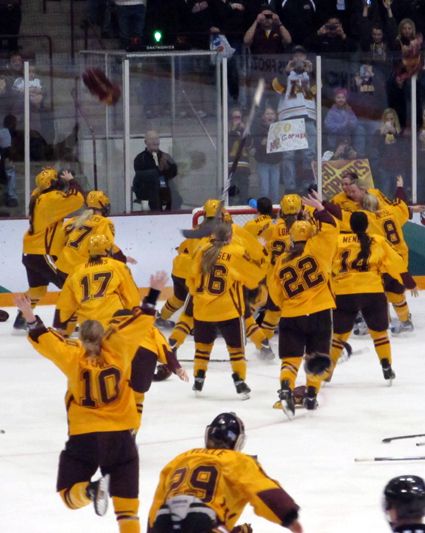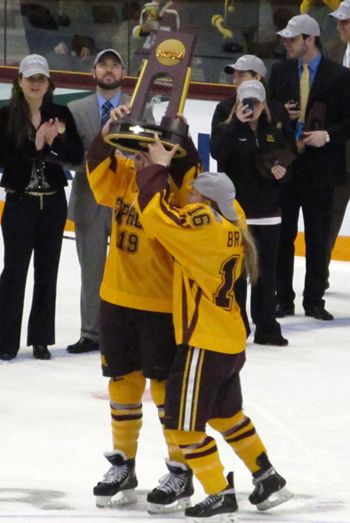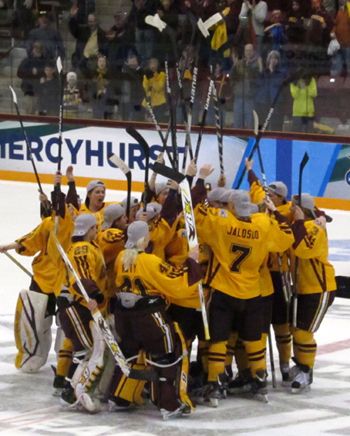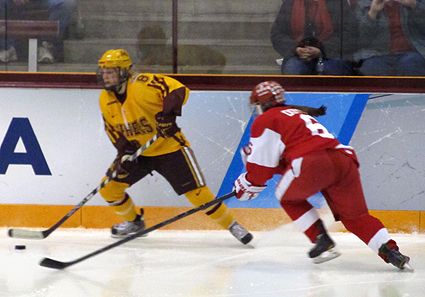Friday, March 29, 2013
1983-84 Winnipeg Jets Dale Hawerchuk Jersey
Dale Hawerchuk scored 103 points for the Cornwall Royals of the QMJHL in 1979-80 and followed up his stellar rookie season with another astonishing 45 points in 18 playoff games from 20 goals and 25 assists to lead the Royals in playoff scoring on their way to the 1980 Memorial Cup championship. He was subsequently named as the league's Rookie of the Year and Playoff MVP.
Still too young to be drafted, Hawerhcuk returned for a second season with the Royals, leading not only the team but the entire QMJHL with 81 goals and 102 assists for 183 points in just 72 games, an average of over 2.5 points per game. He tied with future NHL head coach Marc Crawford to lead the Royals in playoff points with 35 as the Royals became back-to-back Memorial Cup champions.
Hawerchuk was then named the Memorial Cup MVP as well as the QMJHL Player of the Year as well as the CHL Player of the Year, making him the prime pick in the upcoming draft.
That same season Hawerchuk made his international debut for Canada, playing in the 1981 World Junior Tournament, making a name for himself with 5 goals and 9 points in 5 games.
Thanks to their distant last place finish during their second season of play in the NHL following the demise of the WHA, the Winnipeg Jets were in prime position to select Hawerchuk with the first overall pick in the 1981 NHL Entry Draft.
Hawerchuk did not disappoint, leading the Jets to an NHL record 48 point single season improvement in the standings thanks to a team leading 45 goals and 103 points, making him the youngest player to ever reach 100 points. Additionally, he played in that season's NHL All-Star Game and won the Calder Trophy as the league's Rookie of the Year.
Following the Jets early exit from the playoffs, he made his World Championships debut, scoring three times on his way to earning a bronze medal.
Another 40 goal season followed in 1982-83 before he reeled off five consecutive seasons of 100 points or more, highlighted by his stellar 1984-85 season of 53 goals and 77 assists for 130 points, all career highs, which saw him finish 3rd in the NHL scoring race. His 50th goal on this date in 1985 made him the first Jets player to ever score 50 goals in a season in a 5-5 tie against the Chicago Black Hawks. This was also the same season when Hawerchuk was named as the Jets team captain.
During that stretch of 100+ point seasons from 1983-84 to 1987-88, Hawerchuk also participated in the 1986 World Championships (6 points in 8 games, earning a second bronze medal), Rendez-vous '87, in which a team of NHL All-Stars took part in a two game series against the Soviet Union, and the prestigious 1987 Canada Cup, during which he scored 4 goals and 6 points in 9 games as Canada emerged victorious.
While his streak of 100 point seasons would end in 1988-89 with "just" 96 points, he would extend his streak of consecutive 40 goal seasons to five. With the Jets missing the playoffs, Hawerchuk would captain Team Canada at the 1989 World Championships in Stockholm, Sweden, totaling 12 points in 10 games as the Canadians brought home a silver medal.
He would play one final season in Winnipeg before being traded to the Buffalo Sabres, along with a first round draft pick (which became Brad May) , in a blockbuster trade for Phil Housely, former Royals teammate Scott Arniel, Jeff Parker and Buffalo's first round pick, which the Jets used to select Keith Tkachuk.
Hawerchuk's goal scoring in Buffalo not approach is totals in Winnipeg, but his playmaking skills would come to the fore, as he helped set up snipers such as Dave Andreychuk, Pierre Turgeon, Alexander Mogilny and Pat LaFontaine, which allowed him to lead the club in scoring in 1991, 1992 and 1994, with a high of 98 points in 1991-92.
Prior to his second season with Buffalo, Hawerchuk made his final international appearance, skating once again for Team Canada at the 1991 Canada Cup, contributing 5 points in 8 games as the Canadians again won the tournament for the second time in his career.
For the 1995-96 season, Hawerchuk signed as a free agent with the St. Louis Blues, where he played 66 games of the 1995-96 season, which included his 500th NHL goal before a trade to the Philadelphia Flyers for the final 16 games of the season. He would return to the Flyers for the final season of his career in 1996-97, although he was limited to 51 games of the regular season, Hawerchuk closed out his career with the longest playoff run of his career which concluded with his only appearance in the Stanley Cup Finals.
Hawerchuk's final NHL totals were 518 goals and 891 assists for 1,409 points, which still ranks as #18 all-time 15 years after his retirement.
Following his career, Hawerchuk was inducted into the Hockey Hall of Fame in 2001, had his #10 retired by the relocated Jets, now known as the Phoenix Coyotes, in 2007 and named to the Buffalo Sabres Hall of Fame in 2011.
Today's featured jersey is a 1983-84 Winnipeg Jets Dale Hawerchuk jersey. This style Jets jersey was first worn in 1979-80 as the Jets marked a new era in franchise history as they gained entry into the NHL. This style would be worn through 1989-90 when the club changed to a new style, and would be the only style worn by Hawerchuk while a member of the Jets.
Bonus jersey: Today's bonus jersey is a 1989 Team Canada Dale Hawerchuk jersey as he captained Canada to a silver medal at the World Championships. This jersey was produced by Tackla and featured the company's diamond shape logo along the shoulders. Tackla supplied jerseys for the World Juniors, the World Championships and the Olympics from 1987 to 1993.
Today's video section begins with one of our favorite videos of all time, Les Dale Hawerchuks performing their utterly brilliant song "Dale Hawerchuk".
Next, an extended look at the playing career of Hawerchuk.
Labels:
Canada,
Hawerchuk Dale,
Winnipeg Jets
Thursday, March 28, 2013
1989-90 Winnipeg Jets Laurie Boschman Jersey
Following a stellar season with the Brandon Wheat Kings in which he scored 66 goals and 149 points as well as 215 penalty minutes, center Laurie Boschman was drafted 9th overall in the 1979 NHL Entry Draft by the Toronto Maple Leafs.
Boschman's first season in Toronto went well enough for an NHL rookie, as he played 80 games and scored 48 points, but year two was derailed by a bought of mononucleosis, from which he returned too quickly and lacked the necessary energy to compete at the NHL level as a result. Worse, he was criticized by the notoriously cantankerous Maple Leafs owner Harold Ballard for being too soft as a result of a religious conversion. Despite the "soft" accusations, Boschman racked up 178 penalty minutes in just 53 games that season.
A third abbreviated season in Toronto was cut short by a stomach ulcer before Boschman requested a trade and was dealt to the Edmonton Oilers in time for the final 11 games of the 1981-82 season, freeing him from Ballard's criticisms. After playing the majority of the 1982-83 season with the Oilers, Boschman was once again on the trading block due to the depth of the Oilers roster. He landed in Winnipeg with the Jets, a move which would fit him like a glove.
After playing four NHL seasons with a high of 48 points, his first full season with the Jets would see his production immediately increase to 74 points despite playing in just 61 games due to time missed with a separated shoulder. He would also total 234 penalty minutes, making him a true power forward.
The following season Boschman set a career high with 76 points, which included another career best of 32 goals, one of a record six Jets to score 30 or more goals. After scoring 69 points, along with a career high of 241 penalty minutes, Boschman's offensive production would decline somewhat as his season totals were in the 40's in 1987 and 1988 before 36 in 1989 and 27 in his final season in Winnipeg in 1989-90.
After eight stable years in Winnipeg, Boschman was sent to the New Jersey Devils where he would play for two seasons.
He was then left unprotected in the 1992 NHL Expansion Draft by the Devils, and was subsequently selected by the Ottawa Senators, who named him their first captain in team history. Boschman would play 70 games for the Senators that season, which would include his 1,000th NHL game on this date in 1993.
While the Senators would rarely win a game during their first season, going 10-70-4 for a meager 24 points, Boschman would appear in 70 games, his 12th consecutive season with 61 games or more. He would retire following his only season with the Senators, but would return for seven games, in which he scored 18 points, with the Fife Flyers of the British Hockey League in 1994-95 before retiring for good.
Today's featured jersey is a 1989-90 Winnipeg Jets Laurie Boschman jersey as worn during his final season in Winnipeg. This jersey has the Goals for Kids patch worn for the first time in 1988-89, although with the different design which incorporated the Jets logo.
This was the only season during which this style jersey, first introduced back in 1979 when the Jets entered the NHL after the demise of the WHA, with this style of Goals for Kids patch, as the following season would see an all new Jets jersey style that had not only a new Goals for Kids patch, but stripes around the arms rather than down the length of the arms.
Bonus Jersey: Today's bonus jersey is a 1992-93 Ottawa Senators Laurie Boschman jersey as worn during the Senators inaugural season in which they wore the Stanley Cup Centennial patch. Boschman was named the Senators original captain that season, one in which he played in his 1,000th NHL game.
Today's video segment begins with Boschman having a good scrap with the Rangers Doug Weight.
Here is the most famous goal Boschman didn't score - a disallowed goal in the 1991 playoffs which would have completed a Devils comeback from three goals down while leading 3 games to 2. Pittsburgh went on to win the game and eventually the Stanley Cup.
Labels:
Boschman Laurie,
Winnipeg Jets
Wednesday, March 27, 2013
1993-94 Buffalo Sabres Dominik Hasek Jersey
The 1993-94 NHL season concluded with a record number of shutouts, as the various goaltenders combined for 99 regular season shutouts, led by Patrick Roy, Dominik Hasek and Ed Belfour with 7 apiece.
Dominik Hasek
Hasek and the Sabres finished sixth in the Eastern Conference with a 43-32-9 record for 95 points and drew the New Jersey Devils, who finished with the second best record in the conference at 106 points, but were seeded third behind the division winning New York Rangers (112 points) and Pittsburgh Penguins (101).
The Sabres were led by Dale Hawerchuk's 33 goals and 86 points, followed by Russian Alexander Mogilny's 32 goals and 79 points. No other Sabre reached 60 points that season. Hasek played in 58 games during his second season in Buffalo, up from 28 the year before, as he split time with Stanley Cup champion Grant Fuhr in the Sabres net. Hasek's 30 wins were good for 6th place in the NHL that season.
The Devils were led in scoring by defenseman Scott Stevens 78 points from 18 goals and 60 assists. The forwards were led by Stephane Richer's 72 points from 36 goals and 36 assists. John MacLean led the club in goals with 37 on his way to 70 points.
That season's Calder Trophy winner Martin Brodeur led the Devils goaltenders with 47 games played and 27 wins, dividing his time with Chris Terreri, who won 20 of his 44 games played.
Brodeur with the Calder Trophy
The Sabres won the opening game of their playoff series on April 17, 1994 when Hasek blanked the Devils 2-0 in New Jersey. Hasek made 30 saves in the contest to make Todd Simon's power play goal late in the first period stand up until Mogilny sealed the game with an empty net goal with nine seconds remaining.
Two nights later the Devils evened the series by winning 2-1 when Stevens scored at 13:39 of the third period to restore the New Jersey lead after Mogilny had tied the game for Buffalo at the 38 second mark of the third period. Brodeur finished with 23 saves to Hasek's 30 to get the first playoff win of his career.
The series then shifted to Buffalo on April 21st where the Devils repeated their 2-1 victory of Game 2. Richer opened the scoring at 19:01 of the first period and Tommy Albelin scored the vital second Devils goal at 15;43 of the second. Brodeur allowed a power play goal to Mogilny on the power play at 4:08 of the third period to make it a tense final 16 minutes, which included killing off a penalty at 11:54, but the Devils held on behind Brodeur's 29 saves compared to Hasek's 24.
Game 4 on the 23rd saw the two teams combine for as many goals as they had scored in the previous three games combined. The Devils opened the scoring at 9:11 of the first period on the power play, but Buffalo took the lead with two goals within 34 seconds later in the period. The teams traded goals within the first four minutes of the second period to make the score 3-2 for Buffalo, but MacLean tied the game after two periods with a power play goal at 18:36.
Just 30 seconds into the third period Wayne Presley gave the Sabres a lead they would not lose and Rob Ray took some pressure off with his goal for Buffalo at 11:35. The game finished at 5-3 in favor of the Sabres with Hasek making 20 stops to 25 for Brodeur.
Tied at 2 games apiece, the series moved back to New Jersey on April 25th. After Buffalo took a 3-1 lead at the 4:52 mark of the second period, the Devils scored four straight goals over the final 32 minutes to win going away 5-3. Brodeur was credited with 17 saves, while Hasek recorded 30 in the loss.
Martin Brodeur
With the Sabres season now on the brink, they returned home to The Aud on this date in 1994 with no margin for error. The first period passed by scoreless despite three powerplays for Buffalo and two for New Jersey. At the conclusion of the first period, the Sabres held an 11-9 edge in shots on goal.
The second period saw five penalties, two against Buffalo and three for the Devils, including Ken Daneyko's second and third of the game. Despite the number of penalties, neither goalie gave an inch, with Brodeur stopping 10 shots and Hasek 14.
The third period was a close fought battle, with 9 shots for Buffalo to New Jersey's 8. A late penalty on Bobby Carpenter of New Jersey provided the only power play of the period. When Buffalo failed to convert, regulation ended scoreless with a 31-30 edge in shots for the Devils.
The Devils held the edge in play in the first overtime, winning the battle in shots on goal 10-6 with each team getting one power play. Still, the game continued on to a second overtime period as Hasek and Broduer continued to match saves.
A late Buffalo penalty in the first overtime carried over into the second overtime, but still New Jersey could not solve Hasek despite outshooting them 11-8. The remainder of the second overtime passed with no additional penalties as the scoreless game marched on to a third overtime.
Despite no power plays, the Devils took it to the Sabres in the third overtime by putting 14 shots on Hasek to only 5 for the Sabres. Brodeur had to endure one power play for Buffalo, which came at the 12:10 mark. The Sabres man advantage passed without a goal, as did the remainder of the period in this now epic battle.
The first minutes of the fourth overtime saw Hasek turn away 4 Devils shots before center Dave Hannan scored when he pounced on a loose puck and launched a backhander past Brodeur at 5:41 to give Buffalo a 1-0 win after 125:43 of scoreless play to force a Game 7 in New Jersey. It was only the seventh goal Hannan had scored all season, as he had totaled just 6 goals in 83 regular season games.
The final four saves Hasek made in the fourth overtime gave him an even 70 for the game, which set an all-time NHL record for Most Saves by a Goaltender in a Shutout, which still stands today. At the time, it was the 6th longest game in NHL history and still ranks in the top ten.
New Jersey would return home to host Game 7, which they would win 2-1 as Hasek saved 44 of the 46 Devils shots, while the Sabres only managed 18 shots for the entire game, less than the Devils had in the third period alone. Buffalo scored first at 6:00 of the first period on a power play, but it would be their final goal of the series. New Jersey evened the score at 9:53, also on the power play. Claude Lemieux's fourth goal of the series at 13:49 proved to be the difference in this epic battle between two of the finest goaltenders of their generation.
Today's featured jersey is a 1993-94 Buffalo Sabres Dominik Hasek jersey as worn during his record setting 70 save shutout of the New Jersey Devils during Game 6 of their first round playoff matchup on this date in 1994.
Today's video selection is a review of the Sabres and Devils playoff series of 1994, with commentary by Don Cherry and annoying music by some evil musician with a synthesizer and way, way too much caffeine.
This second clip features excitable Sabres announcer Rick Jeanneret's call of Hannan's goal to win Game 6, which included his famous reference to vanished union leader Jimmy Hoffa.
For those of you with three hours to spare, here is a link to the full game on You Tube.
Labels:
Buffalo Sabres,
Hasek Dominik
Tuesday, March 26, 2013
1996-97 Detroit Red Wings Darren McCarty Jersey
On May 29th during Game 6 of the Western Conference Finals of the 1996 NHL playoffs, Claude Lemieux of the Colorado Avalanche checked Kris Draper of the Detroit Red Wings from behind face first into the top edge of the boards in front of the Red Wings bench.
Draper suffered horrible injuries, which included a broken jaw, broken nose, shattered cheekbone, numerous stitches and a concussion.
The Avalanche would go on to defeat the Red Wings and eventually win the Stanley Cup. At the conclusion of the series with Detroit, the Red Wings Dino Ciccarelli said about Lemieux, "I can't believe I shook the guy's friggin' hand after the game. That pisses me right off."
Lemieux's hit which sent Draper face first into the boards
Draper suffered horrible injuries, which included a broken jaw, broken nose, shattered cheekbone, numerous stitches and a concussion.
Draper's injuries following the hit
The Avalanche would go on to defeat the Red Wings and eventually win the Stanley Cup. At the conclusion of the series with Detroit, the Red Wings Dino Ciccarelli said about Lemieux, "I can't believe I shook the guy's friggin' hand after the game. That pisses me right off."
During the 1996-97 season, Colorado and Detroit would meet three times without incident, but Lemeiux was not in the Colorado line up for any of those contests. It was on this date in 1997 that the teams would meet once again, but the stakes were now very different.
At this late date in the season, each club was in position make the playoffs, setting up a possible playoff matchup down the road. In addition, Lemeiux was now going to be in the Colorado lineup, facing off against the Red Wings for the first time in ten months since the savage incident with Draper.
The first fight of the evening occurred at the 4:45 mark of the first period, with another at 10:14. Things really exploded at 18:22, still in the first, as a scuffle between the Red Wings Igor Larionov and Colorado's Peter Forsberg gave the Red Wings Darren McCarty the opportunity he had been waiting for.
Breaking away from an official, McCarty surprised Lemeiux and blasted him in the temple with his glove still on, sending Lemeiux, dazed, down in a heap. McCarty then tore of Lemieux's helmet and began to rain haymakers down on Lemeiux. Unable to defend himself after the sucker punch he had received, all Lemieux could do at that point was cover his head and wait out the assault, which continued unabated as McCarty punched him repeatedly. As one official tried to restrain McCarty, he would even knee Lemeiux in the head along the boards in retribution for his hit on his friend and teammate Draper.
The dazed Lemieux was in no shape to defend himself following the initial blow to the head and did not fight back. To this day he is considered by many to have cowardly "turtled".
At the same time as this was happening, Patrick Roy would come flying out from the Avalanche goal to aid Lemeiux, only to be intercepted by Brendan Shanahan. Roy's arrival on the scene would only serve as an invitation to Mike Vernon to join the battle and eventually the two netminders would square off in one of the classic goalie fights of all time, leaving Roy bloodied as both fighters landed some solid blows.
"As soon as he [Roy] started, I started, " said Vernon. "And then he and Shanny collided. Patrick and Foote were both on Shanahan. The first guy I grabbed at was Foote, which was really a stupid thing to do. Then Patrick kind of jumped me from behind."
"Fight Night at the Joe" would continue just 15 seconds after the puck was dropped when Adam Deadmarsh went after the rugged Vladimir Konstantinov.
The period break had no calming effect, as just four seconds into the second period Adam Foote and Shanahan tried to rearrange each other's dental work. The period continued in a similar fashion when Mike Keane pummeled Thomas Holmstrom and a topless Brent Severyn was held off by Aaron Ward at just 3:34.
Amazingly, McCarty remained in the game following his assault on Lemeiux, having only received a double minor for roughing! Deadmarsh sought retribution for Lemeiux and he and McCarty had a brawl at 7:24. Jamie Pushor and Uwe Krupp then exchanged blows at 11:26.
Meanwhile the score of the game stood at 3-2 in favor of Colorado. Each team would score another goal before the end of the second to make game 4-3 in favor of the Avalanche after two, with six goals having been scored amongst all the fights in the second period.
Things settled down for the most part after the Pushor/Krupp fight, with only a pair of roughing penalties in the third period as Colorado scored to increase their lead to a pair of goals at 1:11, only to have Detroit excite the home fans with goals at 8:27 and 9:03 to tie the contest, which would go to overtime, won by McCarty of all people, 39 seconds into the extra period to give Detroit not only their revenge on Lemeiux, but a 6-5 win over their hated rivals, their first victory over Colorado all season.
"They should have had a few different calls," said Colorado coach Marc Crawford. "The ref told me before the second period that he blew it. That's a small consolation. The linsemen even said it should've been a gross misconduct on McCarty. It's a little ironic that he got the overtime goal."
The game ended with 18 fighting majors and 144 penalty minutes being called. Combatant Vernon got the win in goal for Detroit, the 300th victory of his career.
Asked if he looked forward to a playoff matchup with Detroit, Keane responded , "I've got no problem playing a heartless team. Absolutely, I'd like to play them. We don't like each other. It will make a great series."
The two teams would meet in the Western Conference Finals that season, with Detroit eliminating the defending champion Avalanche in six games, eventually capturing the Stanley Cup with a sweep of the Philadelphia Flyers, a championship whose luster would be tarnished by the limousine crash that would leave Konstantinov in a coma for weeks and ending his career.
For further reading on the intense rivalry between the Detroit Red Wings and the Colorado Avalanche, we suggest "Blood Feud: The Inside Story of Pro Sports' Nastiest and Best Rivaly of It's Era".
Today's featured jersey is a 1996-97 Detroit Red Wings Darren McCarty jersey. This jersey features the Stanley Cup Finals patch worn by the Red Wings and Flyers during all games of the Stanley Cup Finals.
McCarty scored a highlight reel goal for Detroit that put the Red Wings up 2-0 and became the game winner when the Flyers scored an otherwise meaningless goal with 15 seconds left in the game.
Bonus jersey: Today's bonus jersey is a 1995-96 Colorado Avalanche Claude Lemieux jersey as worn during his infamous check which sent Kris Draper into the boards face first, sparking the Avalanche/Red Wings rivalry which would last for seasons to come.
This was the first season for the Avalanche in Colorado after they relocated from Quebec City and they would go on to win the Stanley Cup at the conclusion of that season, thanks in large part to the arrival of goaltender Roy, who would have never have been traded to the franchise had they still been located in Quebec as the Nordiques due to the intense rivalry that existed between the two Francophone clubs.
The jersey was innovative for it's "mountain range" striping along the waist, which was mimicked on the arms and also was made unique by the team's choice of burgundy and light blue, before unused in the NHL.
Here is part one of the fighting from Bloody Wednesday, which includes McCarty's sucker punch on Lemieux and the fight between Roy and Vernon.
This was the first season for the Avalanche in Colorado after they relocated from Quebec City and they would go on to win the Stanley Cup at the conclusion of that season, thanks in large part to the arrival of goaltender Roy, who would have never have been traded to the franchise had they still been located in Quebec as the Nordiques due to the intense rivalry that existed between the two Francophone clubs.
The jersey was innovative for it's "mountain range" striping along the waist, which was mimicked on the arms and also was made unique by the team's choice of burgundy and light blue, before unused in the NHL.
Here is part one of the fighting from Bloody Wednesday, which includes McCarty's sucker punch on Lemieux and the fight between Roy and Vernon.
Next is part two of "The Brawl in Hockeytown."
We hope you have some time on your hands today, as McCarty and Lemieux meet up for the first time ever to discuss the incident and what led up to it, thirteen years after the incident. It's a fascinating insight into "The Code" among hockey players and the mindset of both McCarty and Lemieux both then and now and the respect they have for each other. It's quite possibly the most interesting interview we've ever posted on Third String Goalie.
Labels:
Detroit Red Wings,
McCarty Darren
Monday, March 25, 2013
41-0! The University of Minnesota Golden Gophers Women Win the National Championship
As we reported earlier this season, the defending national champion University of Minnesota Golden Gopher Women's Hockey Team, are a very talented group of highly skilled players who play in a great rink, Ridder Arena, one of only two women's teams in NCAA hockey to have a rink of their own rather than sharing an arena with their college's men's team.
At the time of our last report in early February, the Gophers were 28-0 and had just clinched the WCHA title. After defeating Ohio State twice on the road, they returned home to defeat Bemidji State 8-0 in the first game followed by the one blip on their march through their regular season - a 3-2 win in overtime the next night, the only game of their regular season that would require overtime, which would prove to be their only one goal victory as well. They then completed their perfect 34-0 regular season with back to back shutouts over St. Cloud State on the road.
As luck would have it, the Gophers not only got to host the first round of the league and national playoffs as a higher seed, but both the WCHA conference tournament as well as the NCAA national finals were scheduled for Ridder Arena, giving the team all seven postseason games on home ice.
The first round of the WCHA playoffs saw them defeat Bemidji State with back to back 5-0 and 8-0 shutouts before sweeping the WCHA Final Face-off with a 5-0 win over Ohio State and a 2-0 win over rivals North Dakota, which, dating back to their final two regular season games, gave them six consecutive shutouts and seven of their last eight without allowing a goal.
On to the NCAA playoffs, they were obligated to open against North Dakota, only this time with elimination on the line. In an epic contest, the two teams played a scoreless third period and enter overtime tied at 2-2.
The game saw 17 combined shots in the first overtime and 15 more in the second without a decision. Just when a fourth overtime looked to be a real possibility, Kelly Terry kept Minnesota's dream season alive with a goal with just 1:09 left in the third overtime. For the game, Minnesota's Noora Räty (RAH-too) made 50 saves on 52 shots while North Dakota's Shelby Amsley-Benize stood tall with 57 saves on 60 shots, including 27 in overtime against a team averaging 5 goals a game in league play.
Friday saw the first game of the Women's Frozen Four with #1 Minnesota hosting #4 Boston College. After a scoreless first, BC took the lead on the power play at 18:13 of the second before the Gophers struck for a goal at 1:42 of the third by Hannah Brandt, her 32nd of the year, also on the power play.
Minnesota took the lead at 12:12 but Boston College struck back exactly two minutes later to tie the game, which eventually required overtime, Minnesota's second consecutive such game after a dominant regular season. This one did not need as much time as their game with North Dakota, however, as Sarah Davis pounced on a loose puck and fired it home to send Minnesota into the championship final with their perfect season on the line.
Tickets were sold out and in demand, as scalpers were looking for between $60 and $150 dollars each outside with plenty of fans hoping to get in.
Their opponents were the Boston University Terriers, ranked third in the USCHO.com poll, who came into the NCAA's with a 26-5-3 record. The Terriers tried to break out on top at 5:40 of the first period, but Finland's Räty stopped a BU breakaway to keep the game scoreless.
Minnesota's other Finn, defenseman Mira Jalosuo, then got the Gophers on the board with a shot from the point at 11:38. Brandt then extended the Minnesota lead with a shot from behind the goal and in off the skate of Terriers goalkeeper Kerrin Sperry for a 2-0 margin.
Despite the game's location in Minneapolis, Boston University was well represented by their fans and their energetic band.
Despite their best efforts, neither team could find another goal until Amanda Kessel, the nation's leading scorer, whipped a past Sperry at 16:02. For Kessel, who was named the Patty Kazmaier Award winner on Saturday as the nation's top player, it was her 45th goal of the season.
With Minnesota on a late power play, defenseman Milica McMillen fired a one-timer past Sperry with just 11.8 seconds remaining in the second period to give the Gophers a 4-1 lead with just 20 minutes remaining in the quest for an undefeated season.
But…
Boston University had other plans and Marie-Philip Poulin converted a power play chance just 1:48 into the third period, leaving them plenty of time for two more goals. Both goaltenders stood tall and thwarted several good chances by both teams as the clock began to become the Terriers enemy as time slipped away.
Just because there is no checking in women's hockey, don't think for a minute that's its not rough! Several players were taken down roughly throughout the contest and 8 penalties were called during the game.
Finally, Rachel Ramsey, daughter of 1980 Miracle on Ice Olympian Mike Ramsey, slammed in a pass from Maryann Menefee to give the Gophers some breathing room at 5-2 with 4:33 remaining. Kessel's second assist on the goal was her 100th point of the season, only the fourth woman to ever reach 100.
With nothing to lose and their goaltender pulled, BU made it 5-3 with Janelle Kohanchuk's goal at 17:08 but Kessel put the finishing touch on an undefeated perfect season for the Gophers with her 46th goal of the year into an empty net at 19:11.
Minnesota outshot BU 29-24 for the game and both teams were 2-4 on the power play.
The Gophers finished their back-to-back championship season with a flawless 41-0 season, the first undefeated season in NCAA hockey since Cornell's men's team went 29-0-0 back in 1970. Factoring in their national championship run last season, the program currently sits at 49 games without a loss and still counting.
In addition to Kessel winning the Kazmaier Award, the other two finalists were her Gopher teammates goaltender Räty and team captain defenseman Megan Bozek, the first time all three finalists were from the same team.
Finally, the three Kazmaier nominees, Bozek, Kessel and Räty during their postgame media session after winning the championship at the conclusion of their perfect season.
Ridder Arena
At the time of our last report in early February, the Gophers were 28-0 and had just clinched the WCHA title. After defeating Ohio State twice on the road, they returned home to defeat Bemidji State 8-0 in the first game followed by the one blip on their march through their regular season - a 3-2 win in overtime the next night, the only game of their regular season that would require overtime, which would prove to be their only one goal victory as well. They then completed their perfect 34-0 regular season with back to back shutouts over St. Cloud State on the road.
As luck would have it, the Gophers not only got to host the first round of the league and national playoffs as a higher seed, but both the WCHA conference tournament as well as the NCAA national finals were scheduled for Ridder Arena, giving the team all seven postseason games on home ice.
The first round of the WCHA playoffs saw them defeat Bemidji State with back to back 5-0 and 8-0 shutouts before sweeping the WCHA Final Face-off with a 5-0 win over Ohio State and a 2-0 win over rivals North Dakota, which, dating back to their final two regular season games, gave them six consecutive shutouts and seven of their last eight without allowing a goal.
On to the NCAA playoffs, they were obligated to open against North Dakota, only this time with elimination on the line. In an epic contest, the two teams played a scoreless third period and enter overtime tied at 2-2.
The game saw 17 combined shots in the first overtime and 15 more in the second without a decision. Just when a fourth overtime looked to be a real possibility, Kelly Terry kept Minnesota's dream season alive with a goal with just 1:09 left in the third overtime. For the game, Minnesota's Noora Räty (RAH-too) made 50 saves on 52 shots while North Dakota's Shelby Amsley-Benize stood tall with 57 saves on 60 shots, including 27 in overtime against a team averaging 5 goals a game in league play.
Friday saw the first game of the Women's Frozen Four with #1 Minnesota hosting #4 Boston College. After a scoreless first, BC took the lead on the power play at 18:13 of the second before the Gophers struck for a goal at 1:42 of the third by Hannah Brandt, her 32nd of the year, also on the power play.
Minnesota took the lead at 12:12 but Boston College struck back exactly two minutes later to tie the game, which eventually required overtime, Minnesota's second consecutive such game after a dominant regular season. This one did not need as much time as their game with North Dakota, however, as Sarah Davis pounced on a loose puck and fired it home to send Minnesota into the championship final with their perfect season on the line.
Tickets were sold out and in demand, as scalpers were looking for between $60 and $150 dollars each outside with plenty of fans hoping to get in.
Their opponents were the Boston University Terriers, ranked third in the USCHO.com poll, who came into the NCAA's with a 26-5-3 record. The Terriers tried to break out on top at 5:40 of the first period, but Finland's Räty stopped a BU breakaway to keep the game scoreless.
Minnesota's other Finn, defenseman Mira Jalosuo, then got the Gophers on the board with a shot from the point at 11:38. Brandt then extended the Minnesota lead with a shot from behind the goal and in off the skate of Terriers goalkeeper Kerrin Sperry for a 2-0 margin.
Brandt moments before she scored from behind the net
BU would then counter with a goal from Sarah Lefort after a scramble in front of the Minnesota goal just 16 seconds after the Gophers second goal.
BU gets on the board just 16 seconds after Minnesota's second goal
Despite the game's location in Minneapolis, Boston University was well represented by their fans and their energetic band.
The Terriers fans were in full support of their team
Kesse puts pressure on BU before scoring later in the period
With Minnesota on a late power play, defenseman Milica McMillen fired a one-timer past Sperry with just 11.8 seconds remaining in the second period to give the Gophers a 4-1 lead with just 20 minutes remaining in the quest for an undefeated season.
The Gophers celebrate McMillen's goal, their fourth, late in the second period
But…
Boston University had other plans and Marie-Philip Poulin converted a power play chance just 1:48 into the third period, leaving them plenty of time for two more goals. Both goaltenders stood tall and thwarted several good chances by both teams as the clock began to become the Terriers enemy as time slipped away.
Boston University was still very much alive following their goal early in the 3rd
Just because there is no checking in women's hockey, don't think for a minute that's its not rough! Several players were taken down roughly throughout the contest and 8 penalties were called during the game.
Gopher captain Megan Bozek and Louise Warren hit the deck hard
Finally, Rachel Ramsey, daughter of 1980 Miracle on Ice Olympian Mike Ramsey, slammed in a pass from Maryann Menefee to give the Gophers some breathing room at 5-2 with 4:33 remaining. Kessel's second assist on the goal was her 100th point of the season, only the fourth woman to ever reach 100.
Rachel Ramsey slams in the Gophers fifth goal
With nothing to lose and their goaltender pulled, BU made it 5-3 with Janelle Kohanchuk's goal at 17:08 but Kessel put the finishing touch on an undefeated perfect season for the Gophers with her 46th goal of the year into an empty net at 19:11.
Amanda Kessel's empty net goal sealed the perfect season for Minnesota
The Gophers stream off the bench to begin their celebration of their perfect season
Minnesota outshot BU 29-24 for the game and both teams were 2-4 on the power play.
The Gophers finished their back-to-back championship season with a flawless 41-0 season, the first undefeated season in NCAA hockey since Cornell's men's team went 29-0-0 back in 1970. Factoring in their national championship run last season, the program currently sits at 49 games without a loss and still counting.
Captains Bozek and Bethany Brausen hoist the national championship trophy
The Gophers final salute to the fans of their perfect season
In addition to Kessel winning the Kazmaier Award, the other two finalists were her Gopher teammates goaltender Räty and team captain defenseman Megan Bozek, the first time all three finalists were from the same team.
Patty Kazmaier Award winner Amanda Kessel of Minnesota finished the season with 46 goals and 101 points
Today's video section begins with the Gophers semifinal overtime game against Boston College and Sarah Davis clutch goal.
Next are highlights of the national championship game against Boston University, which gave Minnesota a perfect 41-0 record and their second consecutive national championship.
Finally, the three Kazmaier nominees, Bozek, Kessel and Räty during their postgame media session after winning the championship at the conclusion of their perfect season.
Labels:
University of Minnesota,
Women's Hockey
Subscribe to:
Comments (Atom)

